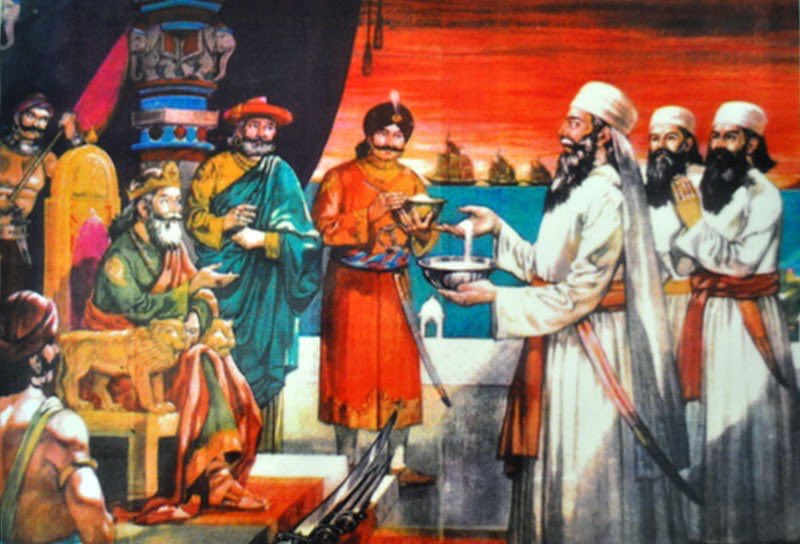Of kings, milk, sugar and saris: The importance of reclaiming the narrative through Refugee Festival Scotland
Published: 26 June 2024
Commentary
In this blog post for the Centre of Public Policy, Dr Dan Fisher discusses the role of narrative in the context of refugee integration and a General Election focused on border control.
Refugee Festival Scotland is in full swing. Across the country communities are coming together to share experiences, learnings, means of making and ways of peaceful living in the world. The means through which these are communicated vary wildly – and excitingly so – from kite flying sessions and cooking classes to football tournaments, discussion sessions and film screenings. Perhaps above all else, food is being shared and stories are being told.
One such story that was recounted to me concerns the that of the founding of Sanjan – a town situated in Gujarat, India.
Assimilation or integration?
As the story goes, in about the year 650CE, the Parsis (descendants of Zoroastrians in Persia) fled modern-day Iran following the fall of the Sasanian Empire to the Muslim Rashidun Caliphate and the subsequent persecution and forceful conversion of Zoroastrians. Upon their arrival in Gujarat, a delegation of Parsi priests met the local Hindu king, Jadi Rana, and requested asylum. Because of the language barrier, the king ordered a vessel be filled to the brim to indicate that there were too many people in his land already. In response, the priests added a spoonful of sugar to the milk – demonstrating that their arrival would sweeten the land and the local culture, rather than leading to an overflow. Impressed, the king granted the Parsis refuge in Gujarat and land on which to establish the settlement of Sanjan.
This is one version of the story.
As with any story written hundreds of years after the events and still passed on through word of mouth, the accounts and their interpretations vary.
Another version of the story tells of how the Zoroastrian priests themselves brought the vessel of milk to the king and then adding the sugar – thereby demonstrating both their value to the king but also their ability to assimilate into the existing culture. The king granted them refuge on the conditions that the Parsis would learn the local language, cease to carry weapons and that the Parsi women would wear the local garments (the Sari).
The overarching narrative of these two versions of the story vary significantly.* The first demonstrates the possibilities of intercultural communication – language barriers are overcome through alternative means of communication in order to create new, shared meanings. Whereas in the second account, the integration of the Parsis takes place through their assimilation into the existing culture; the sugar being that which is extracted in the process.
The current context
Why discuss these two accounts of a story over a thousand years old?
While the Refugee Festival is in full swing, so too is a UK General Election. Both are taking place in the same context, yet the narratives surrounding refugees and integration vary wildly. In the context of immigration, the major parties are promoting narratives of scarcity while emphasising only the benefits of attracting “the brightest and the best” to benefit our economy (and prop up our public services). Meanwhile, as I’ve discussed previously, existing UK Government communication surrounding integration has been primarily assimilationist in its aims.
The Refugee Festival, then, with its football matches and poetry recitals, might not at first glance appear to be an important political endeavour. Yet, especially when placed against the backdrop of UK politics, the festival plays an ever-increasing part in countering narratives of scarcity and the demands for assimilation. The festival shows how there is no singular culture into which people should assimilate; each community event is different, the history of each region distinct and shaped by new arrivals. The sharing of food is less about short-term nourishment and more about a long-term opening up of palettes and ideas.
Finally – and perhaps unlike either of the versions of the story listed above – Refugee Festival Scotland creates the space for refugees to shape their own narratives. To speak their truth to power. To plant seedlings of change that might lead to more wholesome discussions of integration in the future.

Figure 1 Court of Jadi Rana. Image credit: Parzor Foundation
* And, of course, I have told the story in ways the support my purposes. These are in no way the full or definitive accounts of the events that transpired.
This blog was originally published on the Centre for Public Policy's news webpage.
Author
Dr Dan Fisher is a political geographer with an interest in borders, processes of asylum determination and refugee integration. His recent work explores the governance practices of refugee integration and the decision-making processes of forced migrants.
As part of his previous role with the UNESCO Chair for Refugee Integration through the Languages and the Arts, Dan worked on an evaluation of Scotland’s ‘New Scots Refugee Integration Strategy’. His current work also includes analysing judicial determinations of asylum appeals.
First published: 26 June 2024

